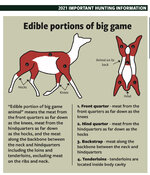I grew up (post-grade school) on our family farm in central Oklahoma. I never hunted deer because it wasn't sporting; I knew where they watered, bed down, raised their young, etc. So, I don't really have any experience with butchering and other things needed for Antelope.
I'm not in a position to spend big money on a turn-key guided hunt. I'm also thinking I'm not in a position to do a DIY Pronghorn hunt. I have shot more feral hogs than I can remember and I have butchered a few so, I have some very basic but crude skills with the actual hunt. I spent about 15 years in Arizona camping and hiking a lot so, I'm not concerned with the non-hunt activities related to the campsite such as meals, medical needs (blisters, sprains, etc.), sleeping bags, boots, etc.
With COVID craziness, I'm probably realistically 2 years out from actually setting off on a hunt at the earliest. Is a DIY Pronghorn hunt realistic for someone like myself? What sort of budget do I need for a hunt, realistically with modest expectations for dining, travel, hotels, etc.? I am open to areas to hunt so, I'm not sure about tag lotteries and similar things or other restrictions for out-of-state hunters. I am a meat hunter so, I care more about body size than I do about trophy size so I'm looking for a reasonable meat hunt. I am also willing to wait for more favorable herd sizes, less disease, etc. to increase my chances of success (i.e. putting meat in the ice chest). I have a passport and have traveled to Canada so, if a Caribou hunt is more practical and affordable, I could go that route but I question getting meat through US Customs via a land crossing and to be blunt, my experiences in Canada were generally pretty expensive for things like hotels, meals, gas, etc. Canada is a lovely place so, I will be back for a vacation at some point post-COVID but, I question the hunt aspects of Canada being a reasonable choice for me. Alaska frankly seems way too expensive in general and too big of a challenge for me at this point in my life. This brings me full circle back to Pronghorn somewhere South of the Canadian/American border in the North central CONUS region.
I have a 26" barreled 257 Weatherby as a starting point for my rifle but, I can be swayed to use something else but, my 300 Win Mag isn't appropriate IMHO unless I need to whack nasty bears which suggests my heavy 9.3x62 rifle or an old Mauser 358 Norma Mag is a better "camp rifle" if I need something like that. I'm thinking CONUS only in terms of geography so, I'm not worried about protecting myself from people other than the normal theft type concerns in transit like vehicles, hotel rooms, etc.
If this topic has been beaten to death, please point me in the right direction.
TIA,
Sid
I'm not in a position to spend big money on a turn-key guided hunt. I'm also thinking I'm not in a position to do a DIY Pronghorn hunt. I have shot more feral hogs than I can remember and I have butchered a few so, I have some very basic but crude skills with the actual hunt. I spent about 15 years in Arizona camping and hiking a lot so, I'm not concerned with the non-hunt activities related to the campsite such as meals, medical needs (blisters, sprains, etc.), sleeping bags, boots, etc.
With COVID craziness, I'm probably realistically 2 years out from actually setting off on a hunt at the earliest. Is a DIY Pronghorn hunt realistic for someone like myself? What sort of budget do I need for a hunt, realistically with modest expectations for dining, travel, hotels, etc.? I am open to areas to hunt so, I'm not sure about tag lotteries and similar things or other restrictions for out-of-state hunters. I am a meat hunter so, I care more about body size than I do about trophy size so I'm looking for a reasonable meat hunt. I am also willing to wait for more favorable herd sizes, less disease, etc. to increase my chances of success (i.e. putting meat in the ice chest). I have a passport and have traveled to Canada so, if a Caribou hunt is more practical and affordable, I could go that route but I question getting meat through US Customs via a land crossing and to be blunt, my experiences in Canada were generally pretty expensive for things like hotels, meals, gas, etc. Canada is a lovely place so, I will be back for a vacation at some point post-COVID but, I question the hunt aspects of Canada being a reasonable choice for me. Alaska frankly seems way too expensive in general and too big of a challenge for me at this point in my life. This brings me full circle back to Pronghorn somewhere South of the Canadian/American border in the North central CONUS region.
I have a 26" barreled 257 Weatherby as a starting point for my rifle but, I can be swayed to use something else but, my 300 Win Mag isn't appropriate IMHO unless I need to whack nasty bears which suggests my heavy 9.3x62 rifle or an old Mauser 358 Norma Mag is a better "camp rifle" if I need something like that. I'm thinking CONUS only in terms of geography so, I'm not worried about protecting myself from people other than the normal theft type concerns in transit like vehicles, hotel rooms, etc.
If this topic has been beaten to death, please point me in the right direction.
TIA,
Sid

